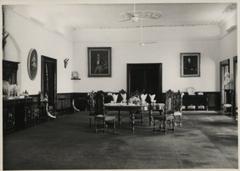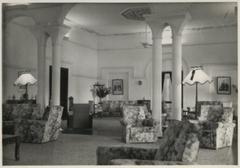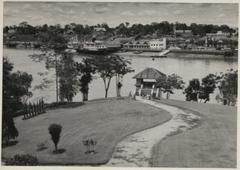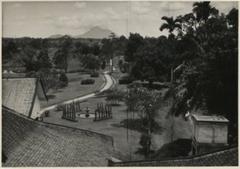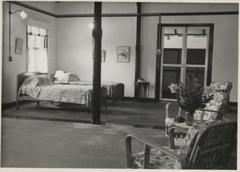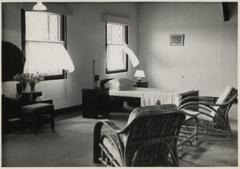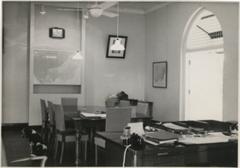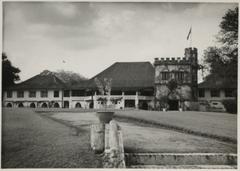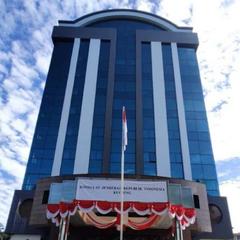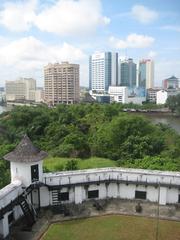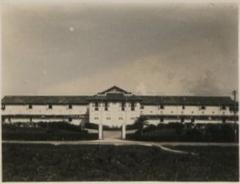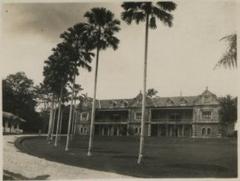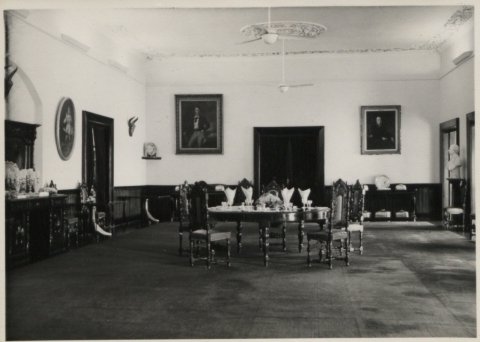
The Astana Kuching: Visiting Hours, Tickets, and Historical Significance Guide
Date: 15/06/2025
Introduction
The Astana Kuching is a majestic and enduring symbol of Sarawak’s colonial heritage, political evolution, and vibrant culture. Situated on the north bank of the Sarawak River, this iconic palace was constructed in 1870 as a wedding gift from Charles Brooke, the second White Rajah of Sarawak, to his wife, Margaret Alice Lili de Windt. The Astana, meaning “palace” in Malay, has served as the residence of the Brooke dynasty and now functions as the official home of Sarawak’s ceremonial Governor. Its commanding presence, colonial architecture, and lush gardens make it a must-see for history enthusiasts and visitors to Kuching (Wikipedia; Kuching Borneo).
Although the palace’s interior remains closed to regular visitors, The Astana’s exterior and gardens provide a meaningful connection to Kuching’s history. The site is a focal point for heritage tours, river cruises, and special state events. Ongoing preservation ensures The Astana remains integral to Sarawak’s identity, while its story—from colonial rule to modern governance—offers insight into the region’s past and present (Sarawak Tourism Board; DBKU Sarawak).
This guide details The Astana’s history, architecture, visiting hours, ticket information, accessibility, visitor tips, and nearby attractions to help you plan a memorable visit.
Historical Overview
Origins and Construction
Built in 1870, The Astana was a wedding present from Charles Brooke to his wife, Margaret Alice Lili de Windt. The couple’s marriage in England the previous year led to the creation of this palace directly opposite the Kuching Waterfront, symbolizing the Brooke dynasty’s authority (Wikipedia; My Backyard Tour). Originally named Government House, the complex consisted of three main buildings connected by covered walkways, reflecting a blend of Western and local architectural influences (Kuching Borneo).
The Brooke Dynasty and Colonial Governance
From 1841 to 1946, the Brooke family governed Sarawak. The Astana was their residence and administrative hub, hosting General Council meetings and welcoming Dayak chiefs. The palace’s design and customs reflected both colonial authority and indigenous alliances (The Edge Malaysia; Malaysia Uncovered).
Wartime and Post-Brooke Era
During World War II, The Astana was occupied by Japanese forces. After the war and Sarawak’s cession to the British Crown in 1946, the palace became the governor’s official residence. Notable historical moments include the 1959 visit by Prince Philip, reinforcing ties with the British monarchy (Dayak Daily).
Modern Significance
Today, The Astana remains the home of Sarawak’s ceremonial Governor and is a venue for state functions. The government has announced plans to convert the palace into a museum to document the lives and contributions of Sarawak’s leaders (Kuching Borneo).
Architectural Features
The Astana’s architecture showcases a harmonious fusion of Victorian, Edwardian, and local Sarawakian styles (The Crazy Tourist; TravelTriangle). The complex comprises three main bungalow-style blocks, connected by covered walkways with wide verandas and high ceilings for tropical ventilation.
Key Details
- Central Block: Symmetrical façade, large arched windows, and doors.
- Flanking Wings: Mirror the central block for visual cohesion.
- Covered Walkways: Timber-supported, pitched roofs.
The white-painted exterior, steep clay-tiled roofs, and ornate wooden balustrades are visually striking and help manage local climate conditions.
Defensive and Landscape Elements
The Astana’s slightly elevated position above the river and its surrounding low wall were subtle defensive measures during the Brooke era. The palace gardens, inspired by English country estates, feature terraced lawns, tropical flower beds, ancient rain trees, and a riverside promenade (DBKU Sarawak).
Visitor Information
Visiting Hours and Tickets
- General Access: The Astana is not open for regular public tours. The palace and its gardens can be admired from the Kuching Waterfront and nearby public areas.
- Special Events: Limited public access is sometimes granted during state festivals or open house events. Check the Sarawak Tourism Board or DBKU Sarawak for announcements.
- Tickets: No tickets are required to view the palace from public spaces. Tickets for special tours or events are typically modest and must be booked in advance when available.
Access and Transportation
- From Kuching Waterfront: The most popular viewing spot. The promenade is wheelchair-accessible and provides excellent photo opportunities.
- By Boat: Sampan and river cruises offer scenic perspectives of the Astana and the New Sarawak State Legislative Assembly (Living Nomads).
- Walking/Cycling: Kuching’s city center and riverbank are pedestrian- and bike-friendly (TravelsPilot).
- Public Transport: Local buses, ride-hailing services, and taxis are available. Limited parking exists near the riverbank.
Accessibility
The Kuching Waterfront and riverside promenade are accessible to wheelchair users. During special events, ramps and designated pathways are available at The Astana. Visitors requiring assistance should contact local authorities in advance.
Visitor Experience
Viewing and Photography
- Best Spots: Kuching Waterfront, river cruises, and Fort Margherita.
- Photography: Early morning and late afternoon offer ideal lighting. The Astana is illuminated at night, creating striking reflections on the river (Living Nomads).
- Guidelines: Photography is permitted from public areas; drone use may require permission.
Facilities and Amenities
- Restrooms: Available at the Kuching Waterfront.
- Food and Beverage: Cafés and street food stalls along the waterfront serve local cuisine (Audiala; Nomadic Samuel).
- Seating and Shade: Benches and shaded areas for relaxation.
- Safety: The area is well-patrolled and generally safe, but visitors should remain vigilant and respect restricted areas.
Practical Tips
- Best Time to Visit: Early mornings or late afternoons for optimal weather and photography.
- Weather: Tropical rain is common; bring rain gear and sun protection.
- What to Bring: Comfortable shoes, water, camera, insect repellent.
Guided Tours and River Cruises
Heritage tours and river cruises often include The Astana as a highlight, offering historical context and unique perspectives. Booking in advance is recommended during peak seasons (TravelsPilot).
Conservation and Heritage
The Astana is recognized as a heritage asset, managed by the Sarawak Museum Department and protected under Malaysia’s National Heritage Act (Brooke Gallery). Conservation follows international standards with minimal intervention, focusing on authentic restoration using traditional methods. Recent projects include roof and timber repairs, masonry conservation, and ongoing preventive maintenance.
Efforts to expand digital documentation and educational outreach ensure The Astana’s legacy is accessible to future generations. Heritage tourism integration, buffer zones, and community engagement are central to the site’s sustainable management (Kuching Borneo; Holidify).
Nearby Attractions
Combine your visit to The Astana with these Kuching highlights:
- Fort Margherita: Historic fort offering panoramic views.
- Sarawak Museum Complex: Comprehensive exhibits on local history and culture.
- Main Bazaar: Traditional shops and local crafts.
- Kuching Waterfront: Iconic promenade with views, entertainment, and dining (TravelTriangle).
Frequently Asked Questions (FAQ)
Q: Can I enter The Astana?
A: The palace is not open for regular tours. Limited access is granted during special events.
Q: Are there tickets required?
A: No tickets are required for exterior viewing. Special events may require advance booking.
Q: Is the area wheelchair accessible?
A: Yes, the Kuching Waterfront and promenade are accessible.
Q: Are guided tours available?
A: Yes, during open days and through heritage tour operators.
Q: Can I take photographs?
A: Yes, from public areas and during special events, but respect privacy and security restrictions.
Conservation References
- Brooke Gallery — Conservation and Restoration
- Kuching Borneo — Urban Development
- Holidify — Kuching Sightseeing
Key Takeaways
The Astana Kuching is a living testament to Sarawak’s dynamic history, blending colonial legacy and cultural evolution. While its interior remains closed, the palace’s dramatic riverside setting, beautiful gardens, and role in state events continue to captivate visitors. Ongoing conservation ensures its preservation for future generations. For a full heritage experience, explore nearby attractions, take a guided river cruise, and check official channels for special event access.
Stay informed through the Brooke Gallery, Sarawak Tourism Board, and DBKU Sarawak.
Plan Your Visit
Download the Audiala app for interactive guides, maps, and exclusive heritage content. Follow us on social media for the latest updates on events, conservation, and Kuching’s living history.
